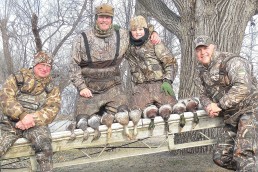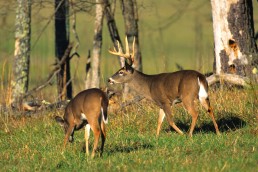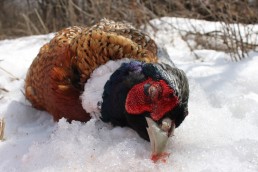The Perfect Mallard Mornings
SHARE THIS POST
Troy Smutka finds that cold, sunny days with light winds are the best for hunting late migrating mallards.
In my home state of Minnesota, we see mallards from the Dakotas and Canada as they migrate south in late October and November, depending on open water and harvested corn fields. They always come through central Minnesota. But if at least some of our water hasn’t frozen, and the corn is harvested, they will collect and stay until a hard freeze of all ponds, lakes and small rivers, or a big snow covering up the fields, moves them further south. With all our rivers and large lakes in central Minnesota, mallards as well as other ducks and geese have open water available to them through November in most years. The wild card is usually snow cover. Most Novembers we have a little or no snow, so the corn fields are a food option and are busy with waterfowl.
Waterfowlers can hunt these birds on water or in the fields, but I am a water duck hunter at heart, brought up doing this, so I opt for water most of the time. Sunny, cold days with a light wind are usually the best hunting days for these late migrating mallards. Cold—but not too cold—gets the birds feeding in the fields most mornings and evenings. Once you get too cold, not only does the water freeze up, but the mallards feed only once a day to conserve energy, often in the middle of the afternoon.
Sunshine helps with waterfowl hunting all season long. Sunshine makes decoys more visible from greater distances, and sunshine creates shadows that help conceal your boat or blind much better than on cloudy days. The best scenario is a south or southwest wind so you can set up with the sun behind you in the birds’ faces as they approach your decoys, rather than in your face.
If I can be choosy, I like a wind at 5 to 10 miles per hour for hunting mallards, over water or in a field. This is enough wind to get decoys moving and force birds to approach from a predictable direction. With no wind, you need to create motion in your decoy spread. Also, birds can land anywhere from any direction. This leads to birds seldom centering up in good shooting position. Gusty winds make calls hard to hear, and slow mallards’ approaches enough that they have longer to look for something wrong. Strong winds also blow approaching birds off center and quickly get them out of range when you come up to shoot.
Are you enjoying this post?
You can be among the first to get the latest info on where to go, what to use and how to use it!
These late-migrating birds have likely encountered a lot of hunters, decoys, calls and blinds on their journeys, so they are well-educated. Use top-quality, realistic decoy spreads, keep calling to a minimum, and make sure you are well-concealed. Movement is the thing waterfowl pick up the most, and the thing that burns hunters the most. Make sure you are still as birds approach, to get them in close.
These late mallards are heavily feathered, and you likely could also encounter some large, heavily feathered geese. So get birds in close before shooting, and use large waterfowl loads in a high-quality shotgun. I use #2s for late-season mallards, and am often shooting, or at least have with, 3 1/2-inch loads for geese that may show up. I am always loaded with 3 1/2-inch in a field, and most often 3-inch over water, as we tend to decoy more geese over fields. The point is, be prepared for big, tough birds.
One final tip: When the mid- to late-morning sun shines warmly on your faces, make sure someone in your party stays awake. It never fails when you nod off, the birds arrive.
If you want to learn more about prime hunting conditions, read the fall issues of MidWest Outdoors, available by subscribing on our website.
MWO
SHARE THIS POST
Did you enjoy this post?
You can be among the first to get the latest info on where to go, what to use and how to use it!
Troy Smutka
Troy Smutka is a central Minnesota fishing guide (greatdayonthewater.com) and a walleye tournament angler. He is also a member of the Lund Boats, Mercury Outboards and Johnson Outdoors Pro Teams, and hosts and produces Fishing and Hunting the North Country on YouTube.



